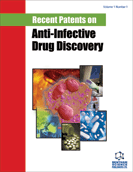Abstract
This article reviews the current literature about the use of intraocular drugs for treatment of bacterial, fungal, viral and protozoal intraocular infection. This route of administration has the advantage of delivering antimicrobials directly into the eye achieving a high therapeutic concentration above the MIC90 of most pathogens and with minimal systemic side effects. It is usually well tolerated but carries a small risk of intraocular complications. Intraocular therapy is now the main therapeutic approach for treatment of bacterial endophthalmitis and has an important adjunctive role in the management of endogenous fungal endophthalmitis and viral retinitis. Intravitreal clindamycin therapy offers a recent additional strategy to treat ocular toxoplasmosis in patients who are intolerant or resistant to systemic treatment. Current researches is now focusing on new patents as well as on the use of intraocular lenses that incorporate antibiotics during cataract surgery and thus provide a sustained high antibiotic levels in the eye in the immediate postoperative period, not depending on patients compliance.
Keywords: Anti-infective therapy, endophthalmitis, retinitis, intravitreal, intracameral, vancomycin, amikacin, ceftazidime, cefuroxime, amphotericin B
 21
21





















